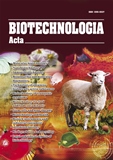ISSN 2410-7751 (Print)
ISSN 2410-776X (Online)

Biotechnologia Acta V. 18, No. 5, 2025
P. 24-29, Bibliography 18, Engl.
UDC: [578.8:57.083]:606
doi: https://doi.org/10.15407/biotech18.05.024
ONCOLYTIC POTENTIAL OF FISH RHABDOVIRUS
Buchatskyi L.P.1, 2, Rud Yu.P 1., Garmanchuk L.V. 3, Gorbach O.I 4
1 Institute of Fisheries of the National Academy of Agrarian Sciences of Ukraine, Kyiv, Ukraine
2 D.K. Zabolotny Institute of Microbiology and Virology, Kyiv, Ukraine
3 Taras Shevchenko National University of Kyiv, Kyiv, Ukraine
4 Nonprofit Organization National Cancer Institute, Kyiv, Ukraine
Aim. The goal of the work was to study the effect of fish rhabdovirus (Spring viraemia of carp virus – SVCV) on cultured human cervical carcinoma (HeLa) cells. This virus is not pathogenic for humans and accumulates in large quantities in vitro, so it is of considerable interest to investigate the possibility of its use as an oncolytic agent.
Methods. For cultivation of fish rhabdovsrus (SVCV) the susceptible fish cell line EPC were used in culture assay. The virus was purified from tissue culture supernatant by the method of ultracentrifugation. Human cervical carcinoma cells of the HeLa line (ECACC catalog no.93021013) were cultured in RPMI-1640 medium (Sigma, USA). Determination of the cytotoxic/cytostatic effect on cells exposed to SVCV was carried out using the MTT test. To determine the distribution of cells by cycle phases under the influence of SVCV and in control cell samples, the method of flow cytofluorimetry was used.
Results. In this work, it is shown for the first time that a fish rhabdovirus significantly inhibits the growth of HeLa cells derived from human cervical carcinoma and causes the appearance of apoptotic bodies in them. Determination of the cytotoxic/cytostatic effect of SVCV, carried out in successively decreasing dilutions of the culture medium, showed that it significantly inhibits the growth of HeLa cells compared to the control at dilutions of 1:2, 1:4 and 1:8.
Conclusions. As the results of our research, it was shown fish rhabdovirus (SVCV) could be included in the extensive list of oncolytic rhabdoviruses. It significantly inhibits the growth of HeLa cells derived from human cervical carcinoma and causes the appearance of apoptotic bodies in them. Further, in vivo studies are needed for a comprehensive evaluation of its oncolytic properties.
Keywords: Fish rhabdovirus, SVCV, oncolysis, cell cultures, apoptosis.
© Palladin Institute of Biochemistry of the National Academy of Sciences of Ukraine, 2025
References
- Cook, M., Chauhan, A. (2020). Clinical Application of Oncolytic Viruses: A Systematic Review. International Journal of Molecular Sciences, 21, 7505. https://doi.org/10.3390/ijms21207505
- Alberts, P., Tilgase, A., Rasa, A., Bandere, , Venskus, D. (2018). The advent of oncolytic virotherapy in oncology: The Rigvir® story. European Journal of Pharmacology. https://doi.org/10.1016/j.ejphar.2018.08.042
- Sugawara, , Iwai, M., Ito, H., Tanaka, M., Seto, Y., Todo, T. (2021). Oncolytic herpes virus G47∆ works synergistically with CTLA-4 inhibition via dynamic intratumoral immune modulation. Mol. Ther. Oncolytics. 22, 129–142. https://doi.org/10.1016/j.omto.2021.05.004
- Liang, (2018). Oncorine, the world first oncolytic virus medicine and its update in China. Current cancer drug targets. 18, 171–176. https://doi.org/10.2174/1568009618666171129221503
- Johnson, D. B., Puzanov, I., Kelley, M.C. (2015). Talimogene laherparepvec (T-VEC) for the treatment of advanced melanoma. Immunotherapy. 7(6), 611– https://doi.org/10.2217/imt.15.35
- Andtbacka,, Kaufman, H. L., Collichio, F., Amatruda, T., Senzer, N., Chesney, J., Delman, K.A., Spitler, L.E.,…, Coffin, R.S. (2015). Talimogene laherparepvec improves durable response rate in patients with advanced melanoma. J Сlin Oncol. 33, 2780–2788. https://doi.org/10.1200/JCO.2014.58.3377
- Seegers, S.L., Frasier, C., Greene, S., Nesmelova, I.V., Grdzelishvili, V.Z. (2020). Experimental Evolution Generates Novel Oncolytic Vesicular Stomatitis Viruses with Improved Replication in Virus-Resistant Pancreatic Cancer Cells. J Virol. 94(3), e01643– https://doi.org/10.1128/JVI.01643-19
- Nagalo, B.M., Zhou, Y., Loeuillard, E.J., Dumbauld, C., Barro, O., Elliott, N.M., Baker, A.T., Arora, M.,…, Borad, M.J. (2022). Characterization of Morreton Virus (MORV) as a Novel Oncolytic Virotherapy Platform for Liver Cancers. Hepatology. https://doi.org/1002/HEP.32769 https://doi.org/10.1101/2022.03.10.483848
- Abdelmageed, A.A., Dewhurst, S., Ferran, M.C. (2025). Employing the Oncolytic Vesicular StomatitisVirus in Cancer Virotherapy: Resistance and Clinical Considerations. Viruses 17, 16. https://doi.org/10.3390/v17010016
- Rud Yu., Buchatsky L. (2023). Fish viruses are a hidden threat to national aquaculture. X International Conference „Bioresources and Viruses“, Kyiv, Abstract book, 37.
- De Pace, N.G. (1912). Sulla scomparsa di un enorme cancro vegetante del callo dell’utero senza cura chirurgica. Ginecologia. 9, 82–88. (In Italian) Corpus ID: 162950580. https://doi.org/10.1101/2022.09.09.507330
- Pack, G.T. (1950). Note on the experimental use of rabies vaccine for melanomatosis. Archives of Dermatology. 62(5), 694–695. https://doi.org/10.1001/archderm.1950.0153018008301 https://doi.org/10.1001/archderm.1950.01530180083015
- Ammayappan, A., Peng, K.W., Russell, S.J. (2013). Characteristics of oncolytic vesicular stomatitis virus displaying tumor-targeting ligands. J Virol. 87(24), 13543–13555. https://doi.org/10.1128/JVI.02240-13
- Felt, S.A., Grdzelishvili, V.Z. (2017). Recent advances in vesicular stomatitis virus-based oncolytic virotherapy: a 5-year update. J Gen Virol. (12), 2895–2911. https://doi.org/10.1099/jgv.0.000980
- Pol, J.G., Zhang, L., Bridle, B.W., Stephenson, K.B., Rességuier, J., Hanson, S., Chen, L., Kazdhan, N.,…, Lichty, D.D. (2014). Maraba virus as a potent oncolytic vaccine vector. Molecular Therapy. 22(2), 420–429. https://doi.org/10.1038/mt.2013.249
- Zhang, Y.,Tesfay, M.,Ferdous, K., Taylor, M., Gabere, M., Simoes, C.C., Dumbauld, C., Barro, O., , Nagalo, B.M. (2022). In vivo Safety and Immunoactivity of Oncolytic Jurona Virus in Hepatocellular Carcinoma: A Comprehensive Proteogenomic Analysis. bioRxiv. 611–619. https://doi.org/10.1101/2022.09.09.507330
- Spivak, N.Ya., Yuzvenko, L.V., Lozova, O.J., Levchuk O.B., Didenko L.F., Nikolaychuk M.V., Potebnya G.P., Tanasienko O.A., Rudik M.P., , Voznesenskaya T.Yu. (2010). Induction of apoptosis of malignant cells of the sarcoma 37 by phytorabdovirus BBV. Bulletin of Uzhgorod University. Series Biology. 27, 40–41.
- Brun, J., McManus, D., Lefebvre, C. Hu, K., Falls, T., Atkins, H., Bell, J.C., McCart, J.A., , Stojdl, D.F. (2010). Identification of genetically modified Maraba virus as an oncolytic rhabdovirus. Mol. Ther. 18, 1440–1449. https://doi.org/10.1038/mt.2010.103

